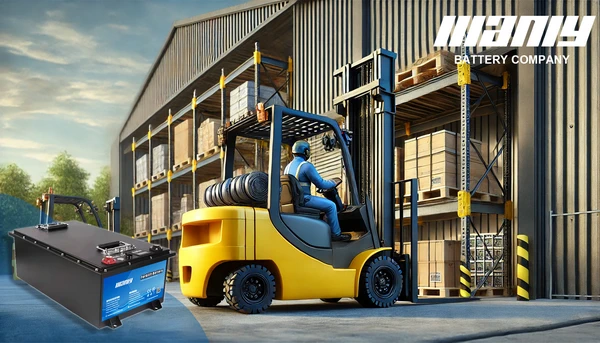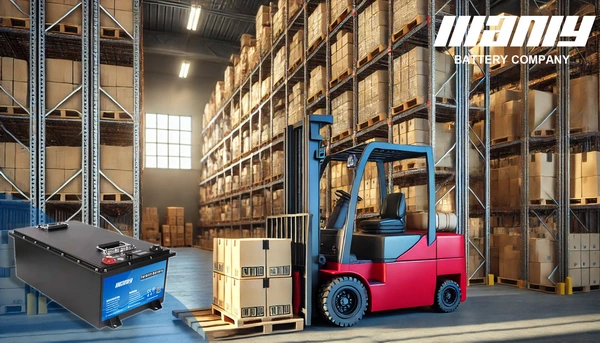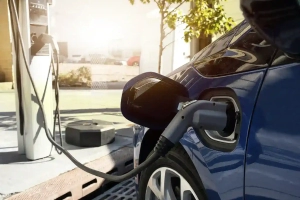When Should Your Forklift Battery Be Recharged?
Table of Contents
- When Should Your Forklift Battery Be Recharged?
- Understanding Forklift Batteries
- General Forklift Battery Recharging Guidelines
- Lithium-Ion Forklift Battery Recharging Guidelines
- Factors Affecting Forklift Battery Charging Time
- Best Practices for Efficient Forklift Battery Charging
- Safety Considerations While Charging Forklift Batteries
- How Does the Size of the Forklift Battery Impact Charging Time?
- Conclusion
- FAQ
- Learn More About Battery

Understanding Forklift Batteries
What is a Forklift Battery?
A forklift battery serves as the primary energy source for electric forklifts, providing the necessary power to lift and transport goods. These batteries are designed to deliver consistent energy output, ensuring that forklifts operate smoothly and efficiently throughout their usage cycles.Types of Forklift Batteries
Lead-Acid Batteries
Lead-acid batteries are the traditional choice for forklifts, renowned for their reliability and cost-effectiveness. They are widely used across various industries due to their robust performance and ability to handle heavy-duty operations. However, lead-acid batteries require regular maintenance, including checking electrolyte levels and ensuring proper ventilation during charging.Lithium-Ion Forklift Batteries
In recent years, lithium ion forklift batteries have gained popularity as a superior alternative to lead-acid batteries. These batteries offer several advantages, including faster charging times, longer lifespan, and lower maintenance requirements. Additionally, lithium-ion batteries provide higher energy density, allowing forklifts to operate longer between charges and reducing downtime.Comparison of Lead-Acid and Lithium-Ion Forklift Batteries
| Feature | Lead-Acid Batteries | Lithium-Ion Forklift Batteries |
|---|---|---|
| Initial Cost | Lower upfront cost | Higher upfront cost |
| Maintenance Requirements | High – requires regular electrolyte level checks and ventilation | Low – minimal maintenance needed |
| Charging Time | Longer – approximately 8 to 10 hours to fully charge | Shorter – typically 1 to 3 hours to fully charge |
| Lifespan | 3 to 5 years with proper maintenance | Up to 10 years or more |
| Energy Density | Lower energy density | Higher energy density |
| Charging Flexibility | Less flexible – needs to be fully charged before use | More flexible – can handle partial charges efficiently |
| Operational Downtime | Higher – longer charging times can lead to more downtime | Lower – faster charging reduces downtime |
| Environmental Impact | Releases gases during charging, requires proper ventilation | More environmentally friendly with no gas emissions |
| Total Cost of Ownership | Higher over time due to maintenance and shorter lifespan | Lower over time despite higher initial cost |
General Forklift Battery Recharging Guidelines
Optimal Charging Frequency
For lead-acid batteries, it's essential to avoid complete discharge, as this can significantly shorten their lifespan. Ideally, you should recharge these batteries when their charge level drops to 20% to 30%. Charging too frequently, such as after every use, can be unnecessary and may not optimize battery performance.Charging Duration
Charging a lead-acid forklift battery typically takes around 8 to 10 hours to reach full capacity. This duration ensures that the battery is thoroughly charged, preventing any loss of energy that could affect forklift performance.Pre-Charging Preparations
Before initiating the charging process, certain precautions must be taken to ensure safety and efficiency:- Choose the Right Spot for Charging: Select a well-ventilated area for charging, especially for lead-acid batteries, which can emit hazardous gases during the process. Proper ventilation helps dissipate these gases, minimizing the risk of explosions or health hazards.
- Wear Safety Gear: Always wear appropriate personal protective equipment (PPE), such as gloves and safety goggles, when handling and charging forklift batteries. This protects against potential acid spills and electrical hazards.
- Check the Battery and Charger: Inspect both the battery and the charger for any signs of damage or wear. Using a damaged charger or a faulty battery can lead to inefficient charging or even accidents. If any issues are detected, consult a battery engineer before proceeding.
- Keep the Forklift Out of the Way: Ensure that the forklift is parked in a secure location away from the charging area. Engage the parking brake to prevent any movement during the charging process, maintaining a safe environment for all personnel.
Lithium-Ion Forklift Battery Recharging Guidelines
Optimal Charging Frequency
Lithium ion forklift batteries offer more flexibility in charging schedules compared to lead-acid batteries. They can be recharged more frequently without degrading their lifespan, allowing for partial charges as needed. This flexibility is particularly beneficial in operations with high forklift usage, as it reduces downtime and maintains consistent productivity.Charging Duration
One of the significant advantages of lithium ion forklift batteries is their rapid charging capability. These batteries can be fully charged within 1 to 3 hours, significantly faster than their lead-acid counterparts. This quick turnaround time enables forklifts to be back in service swiftly, enhancing overall operational efficiency.Pre-Charging Preparations
Charging lithium-ion batteries requires specific considerations to ensure safety and optimal performance:- Safety Considerations: Although lithium ion batteries are generally safer than lead-acid batteries, it's still crucial to follow safety protocols. Ensure that the charging area is free from flammable materials and that the battery is handled with care to prevent any physical damage.
- Charger Compatibility: Use chargers that are specifically designed for lithium-ion batteries. Incompatible chargers can lead to improper charging, reducing battery efficiency and lifespan. Always refer to the manufacturer's guidelines to select the appropriate charger.
- Battery Health Checks: Regularly monitor the condition of lithium ion forklift batteries before charging. Checking for signs of wear, swelling, or other damage can help prevent potential failures and maintain battery performance.

Factors Affecting Forklift Battery Charging Time
Several factors influence the time required to charge a forklift battery effectively. Understanding these can help optimize your charging process, reduce downtime, and extend the battery’s lifespan.Battery Size and Capacity
The capacity of a forklift battery, measured in ampere-hours (Ah), directly impacts the charging duration. For example, a 200 Ah lead-acid battery typically takes twice as long to charge as a 100 Ah battery when using the same charger. Additionally, if the charger’s power output is not proportionate to the battery’s capacity, charging time can increase by up to 50%. Ensuring that your charger matches the battery size is crucial for efficient charging and minimizing downtime.Charger Specifications
The type and power of the charger play a critical role in determining charging speed. Fast chargers can reduce charging times by approximately 60% compared to standard chargers. For instance, a standard charger might take 8 hours to fully charge a 100 Ah lead-acid battery, whereas a fast charger could accomplish the same in about 3 to 4 hours. Investing in higher-capacity chargers can significantly enhance operational efficiency, especially in high-demand environments.Environmental Conditions
Temperature significantly affects battery performance and charging efficiency. Charging in temperatures outside the optimal range of 15°C to 25°C (59°F to 77°F) can reduce charging efficiency by up to 20%. In extreme cold, charging times may increase by 30%, while high temperatures can accelerate battery degradation, potentially reducing overall battery lifespan by 10% or more. Maintaining a controlled environment for charging helps ensure optimal performance and longevity of the battery.Usage Patterns
Frequent and deep discharges of the forklift battery necessitate longer charging times. Batteries that are regularly discharged to below 20% may require 20-30% more time to recharge compared to those that are partially charged. Conversely, consistent partial charging can maintain battery health and reduce the overall time needed for each charging cycle by approximately 15%. Adopting a charging strategy that avoids deep discharges can enhance battery efficiency and extend its operational life.Battery Health and Age
The health and age of the forklift battery also play a significant role in charging time. Older batteries or those that have undergone numerous charge cycles may experience reduced charging efficiency, leading to longer charging times. For example, a battery that is 5 years old may take up to 25% longer to charge compared to a new battery. Regular maintenance and timely replacement of aging batteries are essential to maintain optimal charging performance.Charging Infrastructure
The quality and reliability of the charging infrastructure can impact charging times. Poor electrical connections, inadequate power supply, or malfunctioning chargers can lead to inconsistent charging speeds and extended charging periods. Ensuring that your charging stations are well-maintained and equipped with reliable chargers can prevent unnecessary delays and ensure that batteries are ready for use when needed.Forklift Usage Intensity
The intensity and frequency of forklift usage influence how often batteries need to be charged and, consequently, the charging time required. High-intensity operations that demand continuous forklift use may require more frequent charging sessions, which can cumulatively increase the total charging time needed over a day. Implementing efficient usage schedules and having backup batteries can help manage charging times effectively.Charging Cycles and Depth of Discharge
The number of charging cycles and the depth of discharge (DoD) affect charging times. Batteries subjected to shallow discharges (e.g., 30% DoD) and frequent charging cycles tend to charge faster and maintain their capacity longer. In contrast, batteries that experience deep discharges (e.g., 80% DoD) require longer charging times and may suffer from reduced lifespan. Balancing the DoD with appropriate charging practices can optimize both charging time and battery health.Technological Advancements
Advancements in battery technology and smart charging systems can influence charging times. Modern lithium ion forklift batteries often come with integrated battery management systems (BMS) that optimize charging rates based on real-time battery conditions, reducing charging times by up to 30% compared to older technologies. Utilizing the latest battery technologies and smart chargers can enhance charging efficiency and overall operational productivity.



















